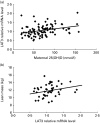Placental amino acid transport may be regulated by maternal vitamin D and vitamin D-binding protein: results from the Southampton Women's Survey
- PMID: 25940599
- PMCID: PMC4498463
- DOI: 10.1017/S0007114515001178
Placental amino acid transport may be regulated by maternal vitamin D and vitamin D-binding protein: results from the Southampton Women's Survey
Abstract
Both maternal 25-hydroxyvitamin D (25(OH)D) concentrations during pregnancy and placental amino acid transporter gene expression have been associated with development of the offspring in terms of body composition and bone structure. Several amino acid transporter genes have vitamin D response elements in their promoters suggesting the possible linkage of these two mechanisms. We aimed to establish whether maternal 25(OH)D and vitamin D-binding protein (VDBP) levels relate to expression of placental amino acid transporters. RNA was extracted from 102 placental samples collected in the Southampton Women's Survey, and gene expression was analysed using quantitative real-time PCR. Gene expression data were normalised to the geometric mean of three housekeeping genes, and related to maternal factors and childhood body composition. Maternal serum 25(OH)D and VDBP levels were measured by radioimmunoassay. Maternal 25(OH)D and VDBP levels were positively associated with placental expression of specific genes involved in amino acid transport. Maternal 25(OH)D and VDBP concentrations were correlated with the expression of specific placental amino acid transporters, and thus may be involved in the regulation of amino acid transfer to the fetus. The positive correlation of VDBP levels and placental transporter expression suggests that delivery of vitamin D to the placenta may be important. This exploratory study identifies placental amino acid transporters which may be altered in response to modifiable maternal factors and provides a basis for further studies.
Keywords: Amino acid transporters; Placenta; Vitamin D.
Figures


References
-
- Harvey NC, Javaid MK, Poole JR, et al. (2008) Paternal skeletal size predicts intrauterine bone mineral accrual. J Clin Endocrinol Metab 93, 1676–1681. - PubMed
-
- Javaid MK, Crozier SR, Harvey NC, et al. (2006) Maternal vitamin D status during pregnancy and childhood bone mass at age 9 years: a longitudinal study. Lancet 367, 36–43. - PubMed
-
- Holick MF, Binkley NC, Bischoff-Ferrari HA, et al. (2011) Evaluation, treatment, and prevention of vitamin D deficiency: an Endocrine Society clinical practice guideline. J Clin Endocrinol Metab 96, 1911–1930. - PubMed
Publication types
MeSH terms
Substances
Grants and funding
- 17702/VAC_/Versus Arthritis/United Kingdom
- MC_U147585827/MRC_/Medical Research Council/United Kingdom
- MC_U147585819/MRC_/Medical Research Council/United Kingdom
- 17702/ARC_/Arthritis Research UK/United Kingdom
- MC_UP_A620_1014/MRC_/Medical Research Council/United Kingdom
- MC_UP_A620_1017/MRC_/Medical Research Council/United Kingdom
- RG/07/009/23120/BHF_/British Heart Foundation/United Kingdom
- MC_UU_12011/1/MRC_/Medical Research Council/United Kingdom
- RG/07/009/BHF_/British Heart Foundation/United Kingdom
- HTA/10/33/04/DH_/Department of Health/United Kingdom
- MC_UU_12011/4/MRC_/Medical Research Council/United Kingdom
- MC_U147585824/MRC_/Medical Research Council/United Kingdom
- G0400491/MRC_/Medical Research Council/United Kingdom
- MC_US_A620_0033/MRC_/Medical Research Council/United Kingdom
LinkOut - more resources
Full Text Sources
Medical

